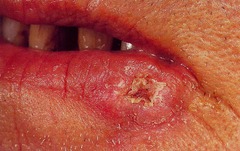General Pathology of the Oral Cavity – Flashcards
Unlock all answers in this set
Unlock answersquestion
Angular Cheilitis
answer
AKA "Cheilosis" or "Angular Stomatitis" Inflammatory lesion at the labial commissure Prone to secondary infection by Candida Usually seen in elderly. May be seen with malnutrition, nutritional deficiency or Fe-deficiency anemia May also be seen in cold weather climates
question
Glossitis
answer
Inflammation or infection of the tongue, causing the tongue to swell Difficulty swallowing Causes may include viral (HSV) or bacterial infections, mechanical injury from burns, sharp edges of teeth or tongue piercings Alcohol and smoking may also cause this Goal of Tx is to reduce inflammation with good oral hygiene
question
Stomatitis
answer
Inflammation of mucous membranes of any oral cavity structures Inflammation may be caused by poor oral hygiene, ill-fitting dentures, mouth burns, cigarette smoking, or infections Severe iron-deficiency enemia may cause this.
question
Oral Mucocele
answer
AKA Mucus Retention Cyst Swelling connective tissue consisting of collected musin from a ruptured minor salivary gland duct Mostly found in children and young adults Most common location is the surface of the lower lip and inner buccal mucosa Round, bluish, firm lesion Histologically contains mucin and granulation tissue
question
Aphthous Ulcer
answer
AKA Canker Sore Painful, open sore caused by a break in the mucous membrane 10% of population One of most common oral conditions Women are more effected Exact cause unknown, associated with lip biting and vigorous brushing Oval, white to yellow ulder with an inflamed red border Usually self-limited
question
Squamous Papilloma
answer
Most common benign epithelial neoplams of oral cavity Affects men more than women, most commonly in ages 30-60 Any oral site may be effected symptomless mass Majority are solitary Possible Viral etiology Exophytic, pink to tan lesions with warty appearance and vary in size. NOT malignant, no malignant potential, treated with surgical removal.
question
Lymphangioma
answer
Benign proliferation of lymphatic vessels that occur as a focal superficial lesion within the oral cavity MC on tongue and mucous membrane of cheek Asymptomatic, painless, soft and slightly raised clear to pink nodule or vesicle Can be present at birth No encapsulation, but still benign Tx is surgical removal
question
Fibroma
answer
MC connective tissue "tumor" of oral cavity MC on buccal mucosa, followed by labial mucosa, tongue and gingiva but can be anywhere. Typically presents as smooth surfaced, firm nodule with broad sessile base. Asymptomatic
question
Minor Salivary Gland Adenoma
answer
Involvement of minor salivary glands occur most frequently on the hard and soft palate, followed by the lips Tend to be lobular or polypoid, encapsulated tan-white masses. Histologically resemble major salivary gland pleomorphic adenomas Slow growing, painless mass. May cause difficulty chewing, dysphagia and hoarseness
question
Tori Mandibularis
answer
Harmless growth of bone in oral cavity Mandible area, hard palate, or inner cheek Slow growing, vary in size, usually dont interfere with chewing or speech Not cancerous or pre cancerous Usually asymptomatic
question
Head and Neck Cancers
answer
Predominantly consist of oral cavity and lip cancers, but also include the nasal cavity and sinuses, pharynx, and larynx Cast majority of these are SCC (95%) Strong association with smoking and alcohol along with exposure to HPV Over 35,000 new cases in US each year
question
Oral Cancer General Considerations/Demographics
answer
Oral Cancers are more common in men - associated with higher incidence of tobacco and alcohol use. 2:1 ratio Average age is 50-70. Usually >40y/o MC cancer in men from India due to chewing Paan.
question
Oral Cancer Risk Factors
answer
Tobacco (Smoking and chewing) Alcohol Sunlight (UV Light) (specific to lips) Dental irritation and poor oral hygiene Immunosuppression Leukoplakia and Erythroplakia HPV Epstein-Barr Virus
question
Precancerous Leukoplakia
answer
Greek for "White plaques" Asymptomatic white patch on the surface of mucous membrane NOT a tumor - but can result in malignant transfer to SCC Equal occurrence in males and females Clinical term, not a Dx MC in buccal mucosa, tongue and floor of mouth Plaques may be solitary or multiple, vary in size, and cannot be scarped 10% are superficial cancer, 8% are invasive carcinoma Eventually 20% become malignant
question
Erythroplakia
answer
More precancerous than Leukoplakia "Red Leukoplakia" or "Dysplastic Leukoplakia" Red, velvety and eroded area Epithelial changes are markedly atypical, leading to higher risk of malignant transformation - <50%
question
Locations of Oral Cancers
answer
Tongue Lower Lip Floor of Mouth Gingiva and Edentulous Alveolar Ridge Hard Palate Buccal Mucosa
question
Cancer of the Tongue
answer
25-30% or all oral cancers Most common site - Lateral and ventral aspect of anterior 2/3rds Main etiology is tobacco and alcohol
question
Cancer of the Tongue Physical Finding
answer
Painless ulcerated or exophytic mass
question
Cancer of the Lower Lip
answer
20-25% of oral cancers Less common in women Has higher survival rates due to cosmetic location
question
Cancer of the Lower Lip Physical Finding

answer
May also appear on the upper lip (10%) Lipstick is protective
question
Cancer of the Floor of the Mouth
answer
20% of all oral cancers Etiology linked to tobacco and alcohol Presents as an ulcerated mass with pain, bleeding, and excessive salivation Chance of invasion into underlying bone (15-30% of patients)
question
Cancer of the Gingiva and Alveolar Ridge
answer
6% of oral cancers Lower jaw more common than upper jaw Edentulous areas more commonly affected than areas with teeth Presents with non-specific findings (Sore throat, difficulty opening mouth) MC clinical appearance is an ulcerated exophytic mass
question
Cancer of the Hard Palate
answer
Among the rarest primary intraoral site of SCC in US More common in southern India Linked to tobacco and alcohol use Presents with ulcerative and exophytic lesion with or without associated pain and/or bleeding 1/3rd have underlying bone invasion in late stages.
question
Cancer of the Buccal Mucosa
answer
2% of oral cancers Early lesions may present with irregular leukoplakic or erythroplakic plaques. Advanced lesiosn appear as ulcerative and infiltrative exophytic masses. Known to spread to other oral regions Etiology associated with smoking, chewing, dip and alcohol.
question
Oral Cancer - Clinical Features
answer
Small lesions may be asymptomatic with minimal clinical findings and vague symptoms Large lesions may present with local or referred pain, difficulty swallowing, speaking, chewing or opening of the mouth. Weight loss may present with extensive metastasis. Metastasize primarily to submandibular, superficial, and deep cervical lymph nodes more than 1/2 of patients to die have distant blood-borne metastasis to liver, lungs, GI or bone. Begin in-situ (Superficially) MC are raised, firm, pearly white lesions with central necrosis and rolled borders
question
Stage 1 of Clinical Staging of Oral Cancers
answer
Cancer is less than 1 inch in size and no lymph node involvement
question
Stage II of Clinical Staging of Oral Cancers
answer
Cancer is more than 1 inch but less than 2 inches with no lymph node involvement
question
Stage III of Clinical Staging of Oral Cancers
answer
Cancer is greater than two inches, with only one lymph node positive on the same side as the lesion
question
Stage IV of Clinical Staging of Oral Cancers
answer
Cancer is of any size with spread to several lymph nodes on one or both sides as the lesion and/or distant metastasis.
question
Treatment and Behavior or Oral Cancers
answer
Early stages (I or II) - Surgery, radiotherapy, or combination Advanced (III or IV) - combination or surgery, radiation and chemotherapy 75% of intraoral SCC are diagnoses at late stages, negatively effecting prognosis
question
Human Papilloma Virus (HPV)
answer
Double-Stranded DNA virus that infects epithelial cells or skin and mucosa Several serotypes with preference to certain areas of the body Most visible form causes common warts
question
Cancer of the Nasal Cavity and Sinuses
answer
Over 60% of SCC arise here Pathogenesis relates to exposure to certain industrial chemicals - Chromium, nickel, and aromatic hydrocarbons. Also associated with woodworking and leather occupations due to cutting oils and textiles More common in males over age 50%
question
Cancer of Nasopharynx
answer
SCC associated with EBV Most frequent of all malignant tumors in China parts of Africa. EBV found in 90% of tumor cells and patients show anti-bodies to EBV in serum in these areas Genetic association in Chinese Most remain asymptomatic for years Tumor can invade into parapharyngeal space, orbit, and cranial cavity resulting in neurologic symptoms of the cranial nerves. Radio sensitive with survival rate <5 years
question
Cancer of Larynx
answer
SCC originating from glottis, epiglottis and subglottis respectively. Most cases related to smoking and alcohol 1% of cancer deaths in US Symptoms of hoarseness, cough and dysphagia Spreads via direct extension to skin, regional cervical lymph nodes, or into blood to lungs



